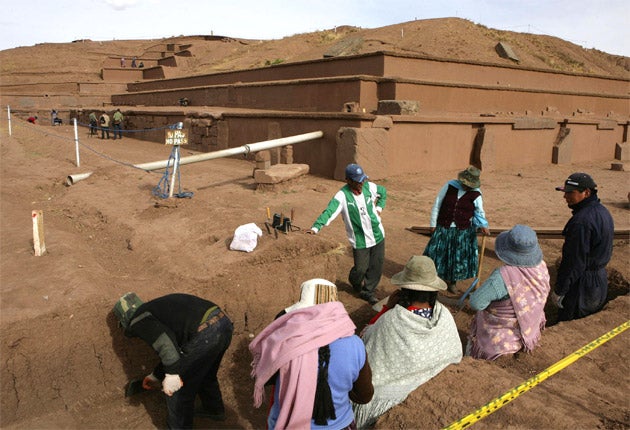With its chipped masonry and missing bricks, the Akapana pyramid in the Bolivian Andes was looking every one of its 1,700 years old. So, in an effort to attract more tourists to the site, locals decided to give it a facelift.
The result, say conservationists, was a botched makeover that destroyed the unique character of the monument, threatens its designation as a Unesco World Heritage Site, and could even cause the ancient pyramid to collapse.
Last year, workmen employed by the nearby town of Tiwanaku, which each year charges thousands of visitors US $10 (£6.25) to visit the pre-Columbus landmark, decided to plaster the pyramid's walls with adobe, a building material made of sand, clay and water, in an effort to make it look smarter.
Ignoring archaeological evidence that the vast structure, sited 12,500 feet above sea level, about 40 miles north of Bolivia's capital, La Paz, was entirely constructed from stone, they decided that a brown clay covering would look prettier in tourist photos.
Now Unesco officials, who take a dim view of historic integrity being sacrificed on the alter of commercialism, are visiting Tiwanaku to investigate whether the site should be struck off the list of World Heritage Sites, which it joined in 2000.
"They decided to go freehand with the [new] design... There are no studies showing that the walls really looked like this," said Jose Luis Paz, who was appointed in June to assess damage at the site, in an interview with the news agency Reuters.
He added that the adobe not only looks wrong, but could also cause the structure to collapse.
The Akapana pyramid, built between AD300 and 700, is one of the biggest ancient constructions in South America. It was first given Unesco status after a team of inspectors agreed that the site's ruins "bear striking witness to the power of the empire that played a leading role in the development of the Andean pre-Hispanic civilisation".
However, the site, which in its heyday contained priceless carvings and ceramics, suffered severe looting after the Spanish conquest and was later used as a quarry. Erosion from high winds also damaged its appearance.
As a result, many modern tourist guides had suggested that the tourist attraction could do with a facelift. The last edition of the Lonely Planet guidebook for Bolivia declared that the pyramid was "in a rather sorry state".
The "improvements", apparently inspired by such comments, were sanctioned by Bolivia's state National Archeology Union, Unar. Government officials have therefore reacted angrily to criticism of the way in which the project was handled.
"Unar has restored the original form the pyramid had," Culture Minister Pablo Groux said. "If we look at pictures from five years ago, there was just a hill there. What we can see now is something close to what the construction originally looked like."
Expulsion from the list of World Heritage Sites would put the Akapana pyramid in unfortunate company, since only two other sites have ever been "deleted" in the list's 37-year history.
One was Oman's Arabian Oryx sanctuary, which lost its status in 2007, after the government made it 90 per cent smaller, causing the number of endangered antelope to fall from 450 to 65.
The other was Dresden's Elbe Valley, wiped off the list this year after the German authorities decided to whack a modern four-lane road bridge across the ancient, picturesque landscape.
Subscribe to Independent Premium to bookmark this article
Want to bookmark your favourite articles and stories to read or reference later? Start your Independent Premium subscription today.


Join our commenting forum
Join thought-provoking conversations, follow other Independent readers and see their replies